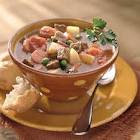Soup is a food that is made by combining ingredients such as meat and vegetables with stock, juice, water or other liquid. A basic tomato soup is simply tomatoes cooked together with celery, onions and carrots for flavoring. Other seasonings may be added, including salt, pepper, sugar, garlic and green pepper, and milk may be used to create cream of tomato soup.
Whether prepared from a can or homemade, tomato soup is a source of vitamin C, vitamin A and iron.
Canned tomato soup is low in calories but high in salt. One cup has 85 calories and 695mg of sodium. This represents 28 percent of the recommended daily value for salt, based on a 2,000-calorie-a-day diet. You'll receive 17g of carbohydrates, which includes 6g of sugars and no dietary fiber.
With only 2g of total fat, tomato soup provides 2 percent of the daily value for total fat. It contains no cholesterol, 0.36mg of saturated fat and 1.4mg of the healthier unsaturated fats.Here is a basic homemade tomato and red pepper soup that is simple and less costly to prepare.
Ingredients:
1 chicken stock
1 tablespoon chopped fresh basil- to garnish
Extra virgin olive oil-to garnish
600g ripe tomatoes- quartered
400g tin chopped tomatoes
2 tablespoon olive oil
1 onion- chopped
2 large red peppers, seeds removed and roughly chopped
2 cloves garlic- chopped
METHOD
1. Heat the olive oil in a large saucepan.
2. Saute the onion, peppers and garlic for about 5 minutes.
3. Add the fresh tomatoes and cook for another 3 minutes.
4 Add the tinned tomatoes, the stock and a cup of water. Bring to the boil, reduce the heat and simmer for 30 minutes.
5. Remove from the heat and allow to cool a little.
6. Puree the soup in batches in a food processor or with a hand-held blender.
7. Strain through a coarse sieve and add a little extra stock.
8. Season to taste with salt and freshly ground black pepper. Serve hot, and garnished with the basil and a of drizzle extra olive oil.
How to Serve:
1. Roasting the vegetables gives the soup a delicious flavor.
2. Halve the onions, tomatoes and peppers, place them on a lined baking tray, drizzle with a little olive oil and roast at 200ºC in oven for 60 minutes, turning the onions and peppers once before using them in the preparation of soup.
Whether prepared from a can or homemade, tomato soup is a source of vitamin C, vitamin A and iron.
Canned tomato soup is low in calories but high in salt. One cup has 85 calories and 695mg of sodium. This represents 28 percent of the recommended daily value for salt, based on a 2,000-calorie-a-day diet. You'll receive 17g of carbohydrates, which includes 6g of sugars and no dietary fiber.
With only 2g of total fat, tomato soup provides 2 percent of the daily value for total fat. It contains no cholesterol, 0.36mg of saturated fat and 1.4mg of the healthier unsaturated fats.Here is a basic homemade tomato and red pepper soup that is simple and less costly to prepare.
Ingredients:
1 chicken stock
1 tablespoon chopped fresh basil- to garnish
Extra virgin olive oil-to garnish
600g ripe tomatoes- quartered
400g tin chopped tomatoes
2 tablespoon olive oil
1 onion- chopped
2 large red peppers, seeds removed and roughly chopped
2 cloves garlic- chopped
METHOD
1. Heat the olive oil in a large saucepan.
2. Saute the onion, peppers and garlic for about 5 minutes.
3. Add the fresh tomatoes and cook for another 3 minutes.
4 Add the tinned tomatoes, the stock and a cup of water. Bring to the boil, reduce the heat and simmer for 30 minutes.
5. Remove from the heat and allow to cool a little.
6. Puree the soup in batches in a food processor or with a hand-held blender.
7. Strain through a coarse sieve and add a little extra stock.
8. Season to taste with salt and freshly ground black pepper. Serve hot, and garnished with the basil and a of drizzle extra olive oil.
How to Serve:
1. Roasting the vegetables gives the soup a delicious flavor.
2. Halve the onions, tomatoes and peppers, place them on a lined baking tray, drizzle with a little olive oil and roast at 200ºC in oven for 60 minutes, turning the onions and peppers once before using them in the preparation of soup.






